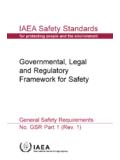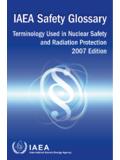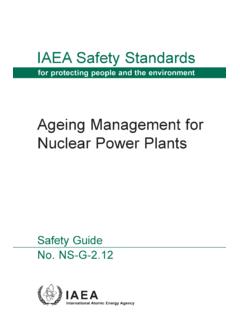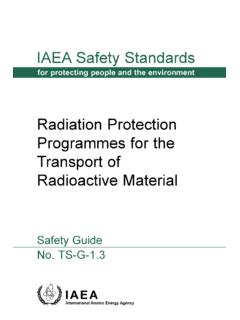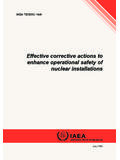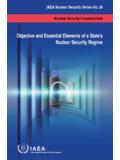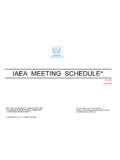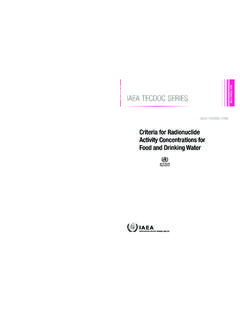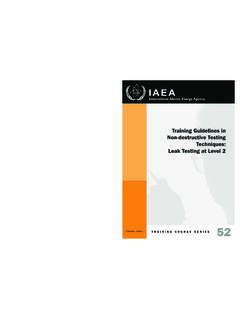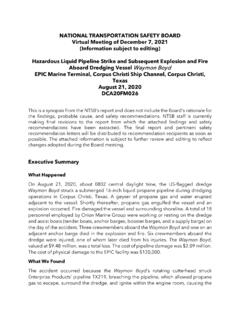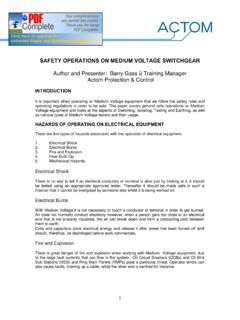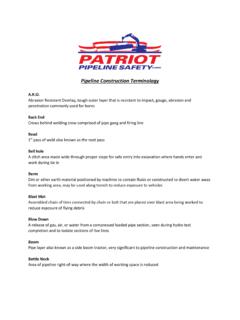Transcription of RADIATION PROTECTION AND SAFETY IN INDUSTRIAL …
1 RADIATION PROTECTION . AND SAFETY . IN INDUSTRIAL RADIOGRAPHY. The following States are Members of the International Atomic Energy Agency: AFGHANISTAN HAITI PARAGUAY. ALBANIA HOLY SEE PERU. ALGERIA HUNGARY PHILIPPINES. ARGENTINA ICELAND POLAND. ARMENIA INDIA PORTUGAL. AUSTRALIA INDONESIA QATAR. AUSTRIA IRAN, ISLAMIC REPUBLIC OF REPUBLIC OF MOLDOVA. BANGLADESH IRAQ ROMANIA. BELARUS IRELAND RUSSIAN FEDERATION. BELGIUM ISRAEL SAUDI ARABIA. BOLIVIA ITALY SENEGAL. BOSNIA AND JAMAICA SIERRA LEONE. HERZEGOVINA JAPAN SINGAPORE. BRAZIL JORDAN SLOVAKIA. BULGARIA KAZAKHSTAN SLOVENIA.
2 BURKINA FASO KENYA SOUTH AFRICA. CAMBODIA KOREA, REPUBLIC OF SPAIN. CAMEROON KUWAIT SRI LANKA. CANADA LATVIA SUDAN. CHILE LEBANON SWEDEN. CHINA LIBERIA SWITZERLAND. COLOMBIA LIBYAN ARAB JAMAHIRIYA SYRIAN ARAB REPUBLIC. COSTA RICA LIECHTENSTEIN THAILAND. COTE D'IVOIRE LITHUANIA THE FORMER YUGOSLAV. CROATIA LUXEMBOURG REPUBLIC OF MACEDONIA. CUBA MADAGASCAR TUNISIA. CYPRUS MALAYSIA TURKEY. CZECH REPUBLIC MALI UGANDA. DEMOCRATIC REPUBLIC MALTA UKRAINE. OF THE CONGO MARSHALL ISLANDS UNITED ARAB EMIRATES. DENMARK MAURITIUS UNITED KINGDOM OF. DOMINICAN REPUBLIC MEXICO GREAT BRITAIN AND.
3 ECUADOR MONACO NORTHERN IRELAND. EGYPT MONGOLIA UNITED REPUBLIC. EL SALVADOR MOROCCO OF TANZANIA. ESTONIA MYANMAR UNITED STATES. ETHIOPIA NAMIBIA OF AMERICA. FINLAND NETHERLANDS URUGUAY. FRANCE NEW ZEALAND UZBEKISTAN. GABON NICARAGUA VENEZUELA. GEORGIA NIGER VIET NAM. GERMANY NIGERIA YEMEN. GHANA NORWAY YUGOSLAVIA. GREECE PAKISTAN ZAMBIA. GUATEMALA PANAMA ZIMBABWE. The Agency's Statute was approved on 23 October 1956 by the Conference on the Statute of the IAEA held at United Nations Headquarters, New York; it entered into force on 29 July 1957. The Headquarters of the Agency are situated in Vienna.
4 Its principal objective is to accelerate and enlarge the contribution of atomic energy to peace, health and prosperity throughout the world''. IAEA, 1999. Permission to reproduce or translate the information contained in this publication may be obtained by writing to the International Atomic Energy Agency, Wagramer Strasse 5, Box 100, A-1400 Vienna, Austria. Printed by the IAEA in Austria January 1999. STI/PUB/1066. SAFETY REPORTS SERIES No. 13. RADIATION PROTECTION . AND SAFETY . IN INDUSTRIAL RADIOGRAPHY. INTERNATIONAL ATOMIC ENERGY AGENCY. VIENNA, 1999.
5 VIC Library Cataloguing in Publication Data RADIATION PROTECTION and SAFETY in INDUSTRIAL radiography. Vienna : International Atomic Energy Energy, 1999. p. ; 24 cm. ( SAFETY reports series, ISSN 1020 6450; no. 13). STI/PUB/1066. ISBN 92 0 100399 4. Includes bibliographical references. 1. Radiography, INDUSTRIAL SAFETY measures. I. International Atomic Energy Agency. II. Series. VICL 99 00214. FOREWORD. The use of ionizing RADIATION , particularly in medicine and industry, is growing throughout the world, with further expansion likely as technical developments result from research.
6 One of the longest established applications of ionizing RADIATION is INDUSTRIAL radiography, which uses both X RADIATION and gamma RADIATION to investigate the integrity of equipment and structures. INDUSTRIAL radiography is widespread in almost all Member States. It is indispensable to the quality assurance required in modern engineering practice and features in the work of multinational companies and small businesses alike. INDUSTRIAL radiography is extremely versatile. The equipment required is relatively inexpensive and simple to operate. It may be highly portable and capable of being operated by a single worker in a wide range of different conditions, such as at remote construction sites, offshore locations and cross-country pipelines as well as in complex fabrication facilities.
7 The associated hazards demand that safe working practices be developed in order to minimize the potential exposure of radiographers and any other persons who may be in the vicinity of the work. The use of shielded enclosures (fixed facilities), with effective SAFETY devices, significantly reduces any RADIATION exposures arising from the work. The demands and rewards of INDUSTRIAL radiography, the ready availability of the essential equipment, the wide range of working conditions and the fact that the techniques employed usually involve the routine manipulation and exposure of powerful gamma emitting sources and X ray machines have all been identified as contributory to the likelihood of accidents.
8 Even in Member States with highly developed regulatory infrastructures, INDUSTRIAL radiographers, on average, receive RADIATION doses that exceed those of other occupationally exposed workers, and individual INDUSTRIAL radiographers are the most likely group of workers to receive doses approaching relevant dose limits. RADIATION PROTECTION and SAFETY in INDUSTRIAL radiography is thus of great importance in both developed and developing countries. This SAFETY Report summarizes good and current state of the art practices in INDUSTRIAL radiography and provides technical advice on RADIATION PROTECTION and SAFETY .
9 It contains information for Regulatory Authorities, operating organizations, workers, equipment manufacturers and client organizations, with the intention of explaining their responsibilities and means to enhance RADIATION PROTECTION and SAFETY in INDUSTRIAL radiography. EDITORIAL NOTE. Although great care has been taken to maintain the accuracy of information contained in this publication, neither the IAEA nor its Member States assume any responsibility for consequences which may arise from its use. The use of particular designations of countries or territories does not imply any judgement by the publisher, the IAEA, as to the legal status of such countries or territories, of their authorities and institutions or of the delimitation of their boundaries.
10 The mention of names of specific companies or products (whether or not indicated as registered) does not imply any intention to infringe proprietary rights, nor should it be construed as an endorsement or recommendation on the part of the IAEA. CONTENTS. 1. INTRODUCTION .. 1. Background .. 1. Objective .. 1. Scope .. 2. Structure .. 2. 2. OBJECTIVES OF RADIATION PROTECTION AND SAFETY .. 2. 3. ORGANIZATIONAL RESPONSIBILITIES .. 4. Regulatory Authority .. 4. The operating organization .. 9. INDUSTRIAL radiographer/worker .. 16. The manufacturers and suppliers.
